Your wedding invitations set the tone for your big day while balancing etiquette and budget. Send them 6-8 weeks before the wedding, using formal or informal language to match your event's style. Include all essential details like names, date, time, and venue. Address envelopes properly and manage RSVPs efficiently. Consider digital options for cost-saving, but weigh guest preferences. Clearly communicate plus-one policies and handle cultural considerations sensitively. Don't forget practical extras like maps or accommodation info. By following these guidelines, you'll create invitations that reflect your love story and respect tradition, without breaking the bank. The perfect invitation awaits as you explore your options.
Key Takeaways
- Combine digital and traditional methods: use cost-effective digital save-the-dates and formal paper invitations for a balance of modernity and tradition.
- Choose simple, classic designs on high-quality cardstock to achieve timeless appeal without breaking the bank.
- Clearly communicate plus-one policies and child-free wedding expectations to avoid confusion and potential overspending.
- Utilize wedding planning apps or spreadsheets for efficient RSVP tracking and guest list management.
- Consider cultural sensitivities in invitation design and wording to ensure inclusivity while maintaining budget constraints.
Timing Is Everything

When it comes to wedding invitations, timing is essential. You'll want to send your invitations early enough to give guests ample time to plan, but not so early that they forget about your big day. Aim to mail your invitations six to eight weeks before the wedding date.
For destination weddings or holiday weekends, send them out even earlier – about three months in advance.
Before the invitations, consider sending save-the-date cards. These should go out six to eight months prior to the wedding, especially if you're expecting out-of-town guests. They'll appreciate the extra time to make travel arrangements.
Set your RSVP deadline for three to four weeks before the wedding. This gives you time to follow up with non-responders and finalize details with your vendors.
If you're sending online invitations, you can set automatic reminders for guests who haven't responded.
Don't forget about other wedding-related events like the rehearsal dinner or post-wedding brunch. Send these invitations after the main wedding invitations, about four to six weeks before the event.
Wording Your Invitations

When you're ready to craft your wedding invitations, you'll need to decide between formal and informal language.
Your choice will set the tone for your event and guide guests' expectations.
Remember to include all essential information, such as the date, time, location, and any special instructions, regardless of the style you choose.
Formal vs. Informal Language
For wedding invitations, the choice between formal and informal language sets the tone for your entire event.
Formal language conveys a traditional, elegant atmosphere, while informal wording suggests a more relaxed, casual celebration.
Formal invitations typically use third-person language and avoid contractions. They'll include phrases like "request the honor of your presence" or "cordially invite you." Full names and titles are used, and dates and times are spelled out. This style is ideal for black-tie affairs or religious ceremonies.
Informal invitations allow for more personality and creativity. You can use first-person language, contractions, and casual phrases like "join us" or "celebrate with us." Nicknames and abbreviated dates are acceptable. This approach suits backyard weddings, destination events, or non-traditional venues.
Consider your venue, dress code, and overall wedding style when deciding between formal and informal language.
Remember, consistency is key. If you choose informal wording, maintain that tone throughout all wedding-related communications.
Whichever style you select, guarantee your invitation clearly communicates essential details like date, time, and location. Your chosen language should reflect your personalities and the atmosphere you want to create for your special day.
Essential Information to Include
Clarity is paramount when wording your wedding invitations. You'll need to include several key pieces of information to guarantee your guests have all the necessary details.
Start with the names of the hosts, typically the bride's parents or both sets of parents. Next, clearly state that you're inviting guests to your wedding celebration.
Include the names of the couple getting married, the date, time, and full address of the ceremony venue. If your reception is at a different location, provide those details separately.
Don't forget to mention any dress code requirements or special instructions, such as "outdoor ceremony" or "adults-only reception."
For RSVPs, include a response deadline and clear instructions on how to reply. If you're using response cards, make sure to include them with pre-addressed, stamped envelopes.
Consider adding your wedding website URL for additional information about accommodations, registry, or travel details.
Remember to proofread your invitations carefully before printing. Double-check all names, dates, and addresses to avoid any embarrassing mistakes.
Addressing Envelopes Properly

For families, you can write "The [Last Name] Family" or list parents' names followed by "and Family."
When inviting children, include their names on the inner envelope. Use formal titles for distinguished guests, such as "The Honorable" for judges or elected officials.
Don't forget to include apartment numbers and zip codes for accurate delivery.
If you're unsure about someone's title or marital status, it's okay to ask.
Remember to use full names and avoid abbreviations on the outer envelope.
Managing RSVPs Efficiently

While managing RSVPs might seem challenging, it's essential for a smooth wedding planning process. Start by setting a clear RSVP deadline, typically 3-4 weeks before your wedding date. This allows ample time for final headcounts and seating arrangements.
Make it easy for guests to respond by including pre-stamped, pre-addressed RSVP cards or providing an online option. Clearly state the RSVP deadline on both the invitation and response card. Number your guest list and subtly mark each RSVP card with the corresponding number to track responses easily.
As RSVPs come in, update your guest list promptly. Don't hesitate to follow up with guests who haven't responded a week after the deadline. A polite phone call or text message can help finalize your headcount.
Consider using a spreadsheet or wedding planning app to organize RSVPs efficiently. Track meal choices, plus-ones, and any additional information you've requested. This data will be invaluable when communicating with vendors and creating seating charts.
Digital vs. Traditional Invitations
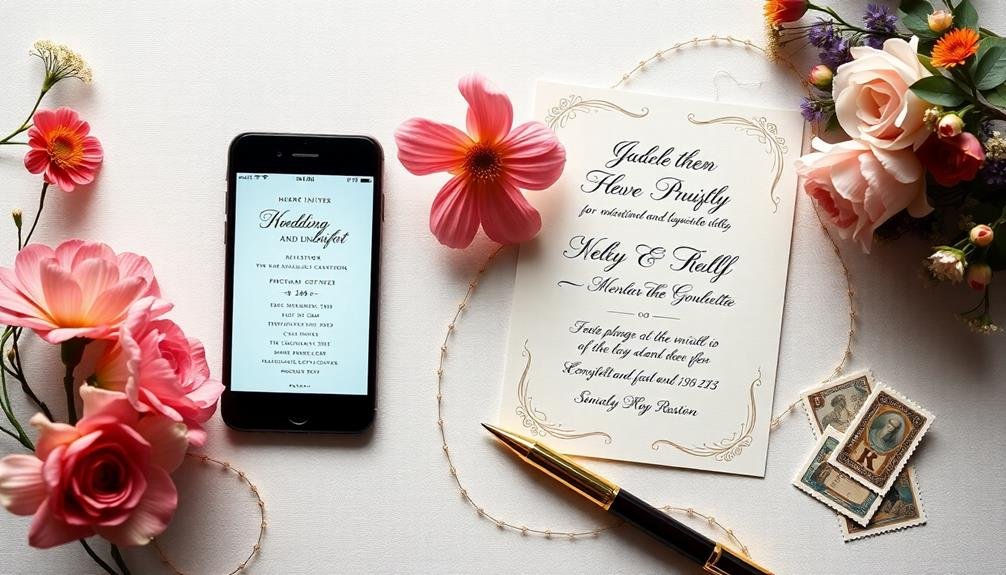
When choosing between digital and traditional wedding invitations, you'll need to weigh several factors.
Consider the cost and convenience of each option, as well as the range of personalization and design choices available to you.
Don't forget to evaluate how each method handles tracking and RSVP management, which can greatly impact your planning process.
Cost and Convenience Comparison
In the digital age, couples face a crucial decision when it comes to wedding invitations: traditional paper or modern digital?
Let's compare the cost and convenience of both options to help you make an informed choice.
Traditional paper invitations often cost more due to printing, paper quality, and postage. They require time for assembly, addressing, and mailing.
However, they provide a tangible keepsake and can be customized with special touches like wax seals or ribbon.
Digital invitations, on the other hand, are typically more budget-friendly and offer instant delivery. They're easily customizable and allow for quick updates if details change.
Plus, you'll save time on addressing and mailing.
Consider these factors when deciding:
- Budget: Digital invitations can save you hundreds of dollars, especially for larger guest lists.
- Time: E-invites are faster to create and send, while paper invitations require more hands-on effort.
- Guest preferences: Consider your audience – older relatives might prefer paper, while tech-savvy friends may appreciate digital.
Ultimately, your choice should reflect your wedding style, budget, and guests' needs.
You can even combine both methods, using digital for save-the-dates and paper for formal invitations.
Personalization and Design Options
Both digital and traditional invitations offer a wealth of personalization and design options, allowing you to create a unique announcement that reflects your style and wedding theme.
Digital invitations provide endless customization possibilities, from animated elements to interactive features. You can easily change colors, fonts, and layouts with a few clicks, and even include music or video elements. Many online platforms offer templates you can modify or the option to design from scratch.
Traditional paper invitations, while more limited in some ways, still provide numerous design choices. You can select from various paper types, textures, and weights, as well as printing methods like letterpress, foil stamping, or embossing. Custom illustrations, calligraphy, and die-cut shapes can add a personal touch.
For a truly bespoke feel, you might consider hiring a stationer to create a completely custom design.
Both options allow for matching additional elements like RSVP cards, information inserts, or thank you notes.
With digital invitations, you can easily create coordinating wedding websites, while traditional invitations can be paired with physical save-the-dates or reception cards for a cohesive suite.
Tracking and RSVP Management
One of the most significant differences between digital and traditional invitations lies in their RSVP management capabilities. Digital invitations often come with built-in tracking systems, allowing you to monitor responses in real-time. You'll receive instant notifications when guests RSVP, making it easier to keep track of your guest list and meal preferences.
Traditional paper invitations, while classic, require more manual effort to manage responses.
When choosing between digital and traditional invitations, consider these key factors:
- Budget: Digital invitations are typically more cost-effective, eliminating printing and postage expenses.
- Guest demographics: Older guests might prefer paper invitations, while younger attendees may appreciate the convenience of digital RSVPs.
- Wedding style: Traditional invitations often suit formal weddings, while digital options can align with modern or destination weddings.
Regardless of your choice, it's essential to have a system in place for tracking RSVPs. Digital platforms often offer automated reminders for guests who haven't responded, saving you time and reducing stress.
If you opt for traditional invitations, consider creating a spreadsheet or using a wedding planning app to manage responses efficiently.
Budget-Friendly Design Tips
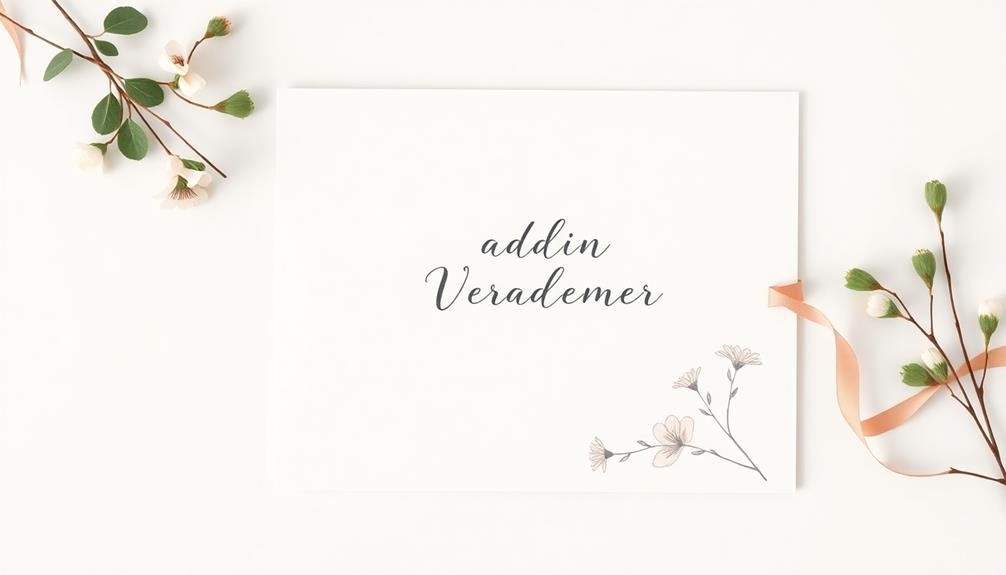
From elegant to rustic, your wedding invitations can reflect your style without breaking the bank. Consider using digital designs and printing them yourself or through a local print shop. This approach gives you control over the process and can greatly reduce costs. Opt for simple, classic designs that won't look dated in years to come.
Choose high-quality card stock, but skip unnecessary embellishments like foil stamping or letterpress. Instead, focus on creative typography and color schemes that align with your wedding theme. You can also save money by using a single-card design instead of multiple inserts.
Here's a breakdown of budget-friendly invitation elements:
| Element | Budget Option | Splurge Option |
|---|---|---|
| Paper | Matte cardstock | Textured or metallic |
| Printing | Digital | Letterpress or foil |
| Envelope | Plain, matching | Lined, custom color |
Don't forget to explore online marketplaces for pre-designed templates you can customize. These often cost a fraction of bespoke designs. Finally, consider sending digital invitations for your save-the-dates and reserve printed invitations for the main event. This hybrid approach can help you allocate your budget more effectively while still maintaining a touch of tradition.
Including Essential Information
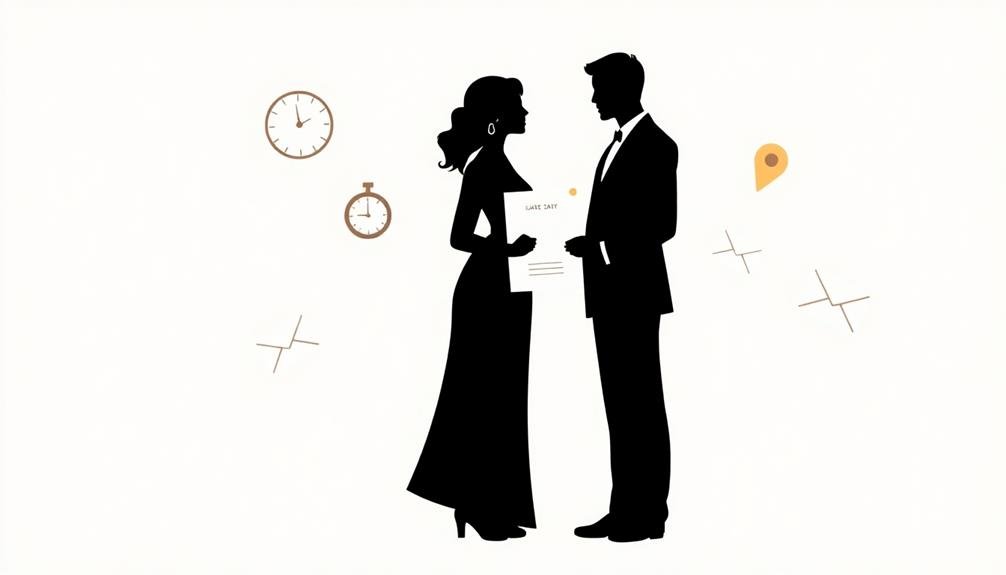
When crafting your wedding invitations, it's essential to include all the necessary information your guests need. Start with the basics: the couple's names, the date, time, and location of the ceremony and reception. Don't forget to mention if they're at different venues. Include RSVP instructions with a deadline and preferred method of response, whether it's a card, website, or phone number.
Consider adding these elements to make your invitations more informative and guest-friendly:
- Dress code expectations (e.g., black tie, cocktail attire, casual)
- Accommodation details for out-of-town guests
- Wedding website URL for additional information
If you're having an adults-only celebration, tactfully indicate this on the invitation. You can phrase it as "adult reception to follow" or address the invite only to the adults.
For destination weddings, include travel information and any planned group activities. If you're offering meal choices, include a spot for guests to select their preference.
Handling Plus-Ones and Children
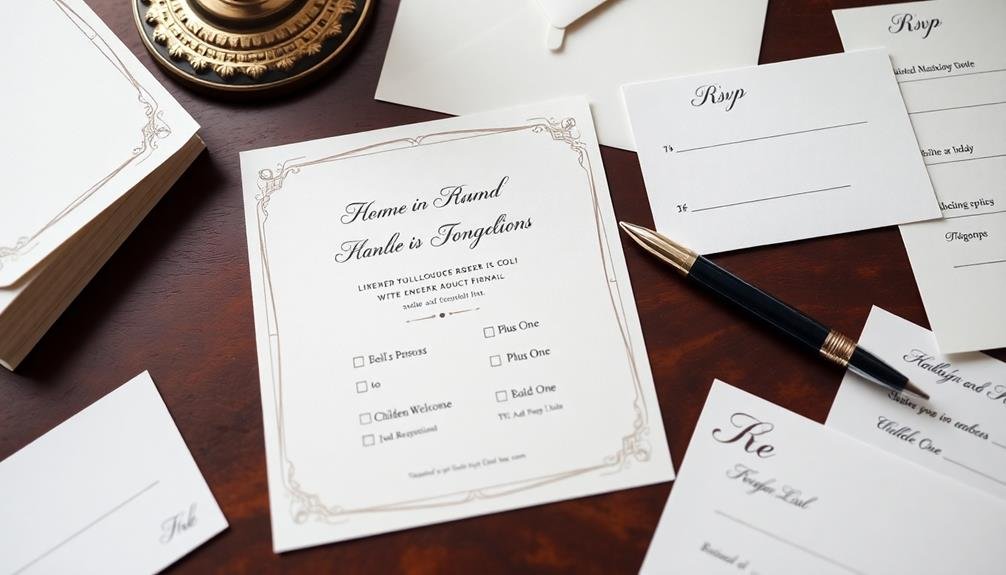
When it comes to plus-ones and children at your wedding, clear communication is key.
You'll need to decide on your plus-one policy and whether you'll host a child-free wedding, then convey these decisions tactfully on your invitations.
Consider addressing guest list limits directly on your wedding website or through personal conversations to avoid confusion and potential hurt feelings.
Plus-One Policy Explained
The thorny issue of plus-ones can be a major headache for couples planning their wedding. You'll need to decide who gets a plus-one and who doesn't, balancing your budget with your guests' expectations. A plus-one policy allows invited guests to bring a date or companion to your wedding, even if you don't know that person.
When crafting your plus-one policy, consider these key factors:
- Relationship status: Typically, married couples, engaged couples, and long-term partners are invited together.
- Wedding party members: It's customary to extend plus-ones to your bridesmaids and groomsmen.
- Out-of-town guests: Consider allowing plus-ones for guests traveling from afar.
Be consistent with your policy to avoid hurt feelings. If you can't afford to give everyone a plus-one, prioritize based on your budget and venue capacity.
Communicate your policy clearly on the invitation or wedding website. For guests without a plus-one, address the invitation to them individually.
Addressing Child-Free Weddings
Be prepared for some guests to inquire about bringing their children. Respond politely but firmly, explaining that you've decided on an adults-only event due to venue restrictions, budget constraints, or personal preference.
Offer alternatives if possible, such as recommending local babysitting services or organizing a group childcare option nearby.
For close family members with young children, you might consider making exceptions or hiring on-site childcare. However, be consistent with your policy to avoid hurt feelings.
If you're worried about offending guests, consider hosting a separate family-friendly event before or after the wedding.
Communicating Guest List Limits
Guest list management can be one of the trickiest aspects of wedding planning. When it comes to communicating guest list limits, it's crucial to be clear and tactful.
You'll need to decide how to handle plus-ones and whether children will be invited. Once you've made these decisions, communicate them consistently to avoid confusion or hurt feelings.
For plus-ones, address invitations to specific individuals or couples. If you're allowing guests to bring a date, include "and Guest" on the invitation.
For child-free weddings, address invitations to adults only and consider adding a note on your wedding website explaining your decision.
Here are three effective ways to communicate guest list limits:
- Use clear wording on invitations and RSVP cards
- Create an informative wedding website with FAQs
- Enlist family and wedding party members to spread the word
Navigating Cultural Considerations
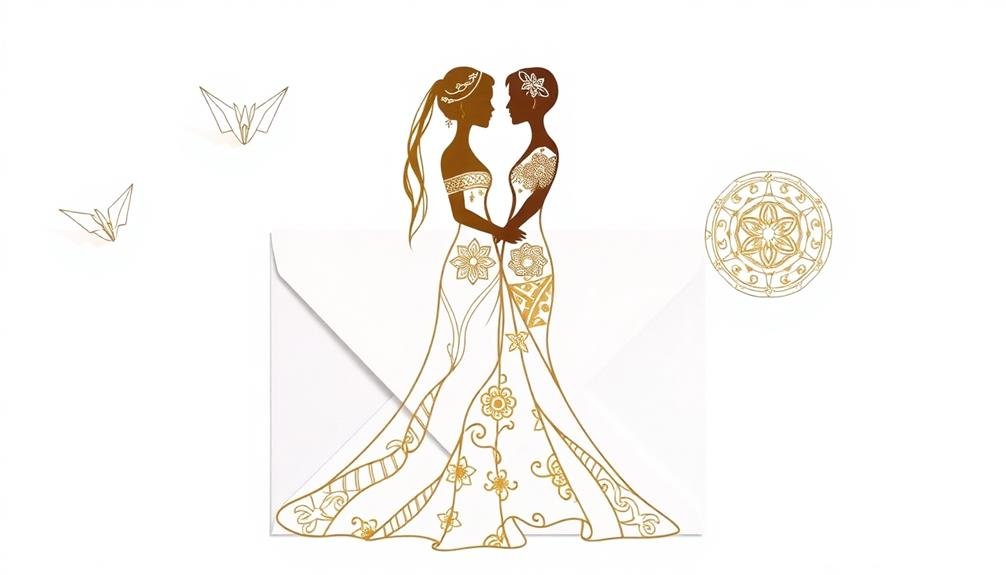
Cultural sensitivity plays an essential role in wedding invitation etiquette. When planning your wedding, it's significant to take into account the diverse backgrounds of your guests and how cultural differences might impact your invitations.
Start by researching the cultural norms of your guests' backgrounds. You'll want to avoid unintentionally offending anyone or creating confusion. For example, in some cultures, it's customary to include parents' names on invitations, while in others, it's not.
Be mindful of language barriers and think about providing bilingual invitations if necessary.
Pay attention to religious customs as well. Some faiths have specific requirements for wedding invitations, such as including certain phrases or symbols. If you're having an interfaith ceremony, make sure your invitations reflect both traditions respectfully.
Timing is another cultural consideration. In some cultures, sending invitations too early or too late can be seen as impolite. Research appropriate timelines for different cultural groups and try to find a middle ground that works for everyone.
Lastly, be aware of color symbolism. Colors carry different meanings across cultures, so choose your invitation palette carefully to avoid any negative connotations.
Invitation Extras and Enclosures
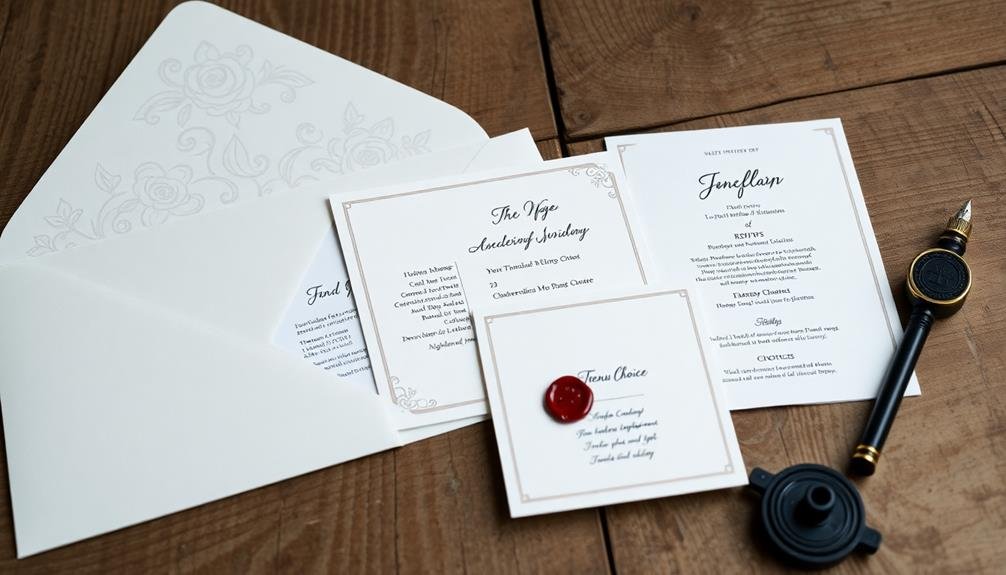
While cultural considerations shape the core of your invitation, the extras and enclosures you include can provide valuable information and enhance your guests' experience. These additional elements can range from practical details to personal touches that reflect your unique style as a couple.
When deciding on invitation extras, consider including:
- RSVP cards with pre-addressed, stamped envelopes
- Directions and accommodation information
- Details about wedding-related events, such as rehearsal dinners or post-wedding brunches
Keep in mind that each enclosure adds to your overall costs, so prioritize what's most important. If you're on a tight budget, you can opt for digital alternatives for some information, like creating a wedding website for detailed directions and accommodations.
Don't forget to include a map if your venue is hard to find or in an unfamiliar area. For destination weddings, consider adding travel information or local attraction recommendations.
If you're having an adults-only reception, tactfully mention this on a separate card rather than on the main invitation.
Frequently Asked Questions
How Do I Politely Request Cash Gifts Instead of Traditional Wedding Presents?
You shouldn't directly ask for cash gifts. Instead, consider creating a wedding website where you can tactfully mention your preference for monetary contributions. You can also spread the word through family and close friends if asked about registry options.
What's the Etiquette for Uninviting Someone After Save-The-Dates Have Been Sent?
It's best to avoid uninviting guests after save-the-dates. If you must, call them personally to explain the situation. Be honest and apologetic. Consider offering to meet up separately to celebrate your marriage in a more intimate setting.
How Should We Handle Invitations for a Adults-Only Destination Wedding?
For an adults-only destination wedding, you'll want to clearly state "adults only" on your invitations. You can also include a note on your wedding website explaining your decision and offering childcare suggestions for traveling guests.
Is It Appropriate to Include Registry Information on Wedding Invitations?
You shouldn't include registry information on your wedding invitations. It's considered impolite and can seem gift-grabby. Instead, spread registry details through word of mouth, your wedding website, or bridal shower invitations. Keep your wedding invites focused on celebrating your union.
How Do We Tactfully Communicate Our Eco-Friendly or Sustainable Wedding Theme?
You can subtly convey your eco-friendly theme on the invitation by using recycled paper or mentioning "green celebration" in the wording. Include a website link where you'll share more details about your sustainable choices and how guests can participate.
In Summary
You've now got the tools to create budget-friendly wedding invitations that are both stylish and proper. Remember, it's all about balancing modern trends with timeless etiquette. Don't be afraid to get creative, but always keep your guests' comfort in mind. Whether you choose digital or traditional invites, make sure they reflect your personality as a couple. With these tips, you'll set the perfect tone for your special day while keeping costs in check.

I’m Sarah, the creator and writer behind this site. I’m a wife and a mother of two wonderful kids who keep me on my toes and inspire me daily. My passion lies in creating and organizing memorable events and group activities, where people can come together and make lasting memories.





Leave a Reply